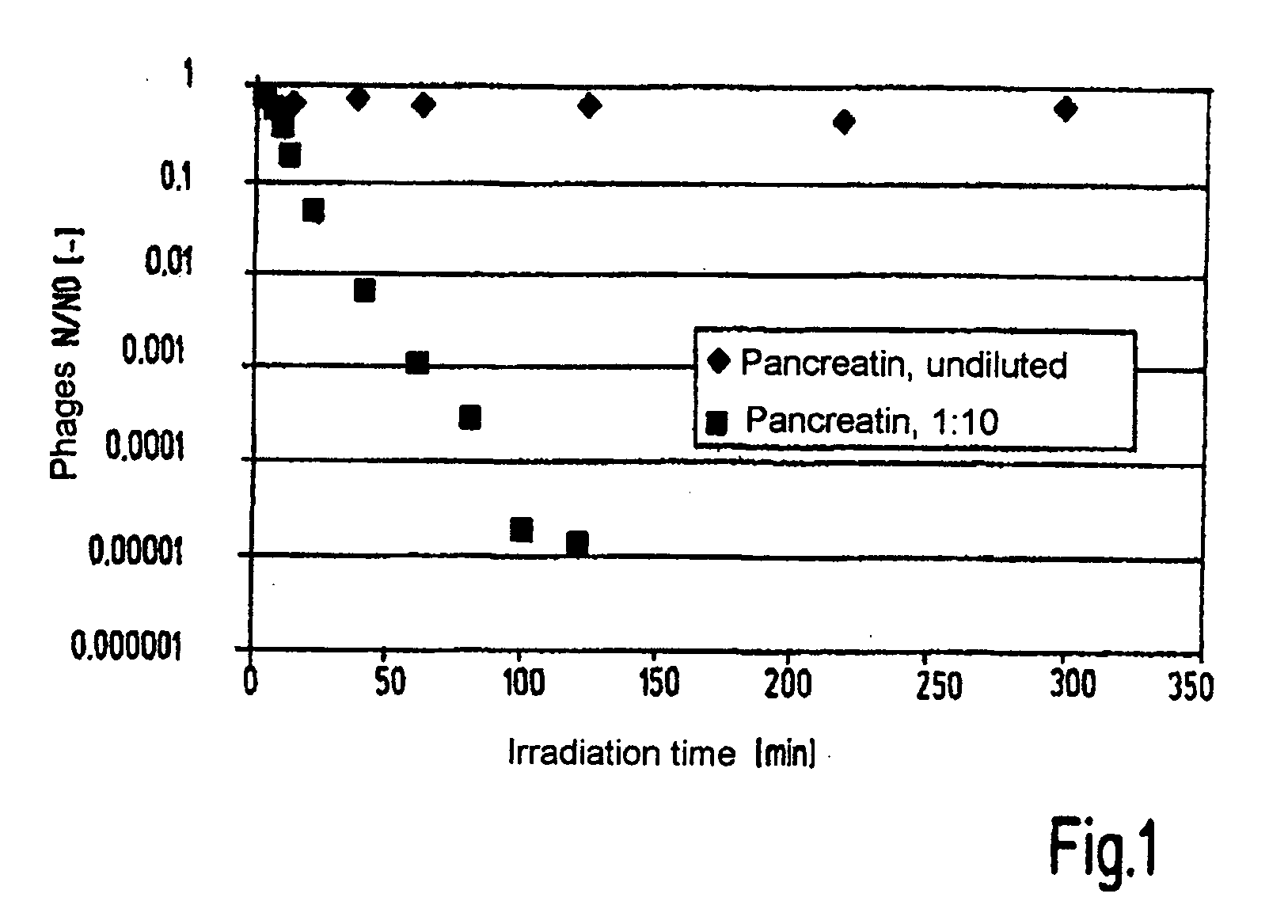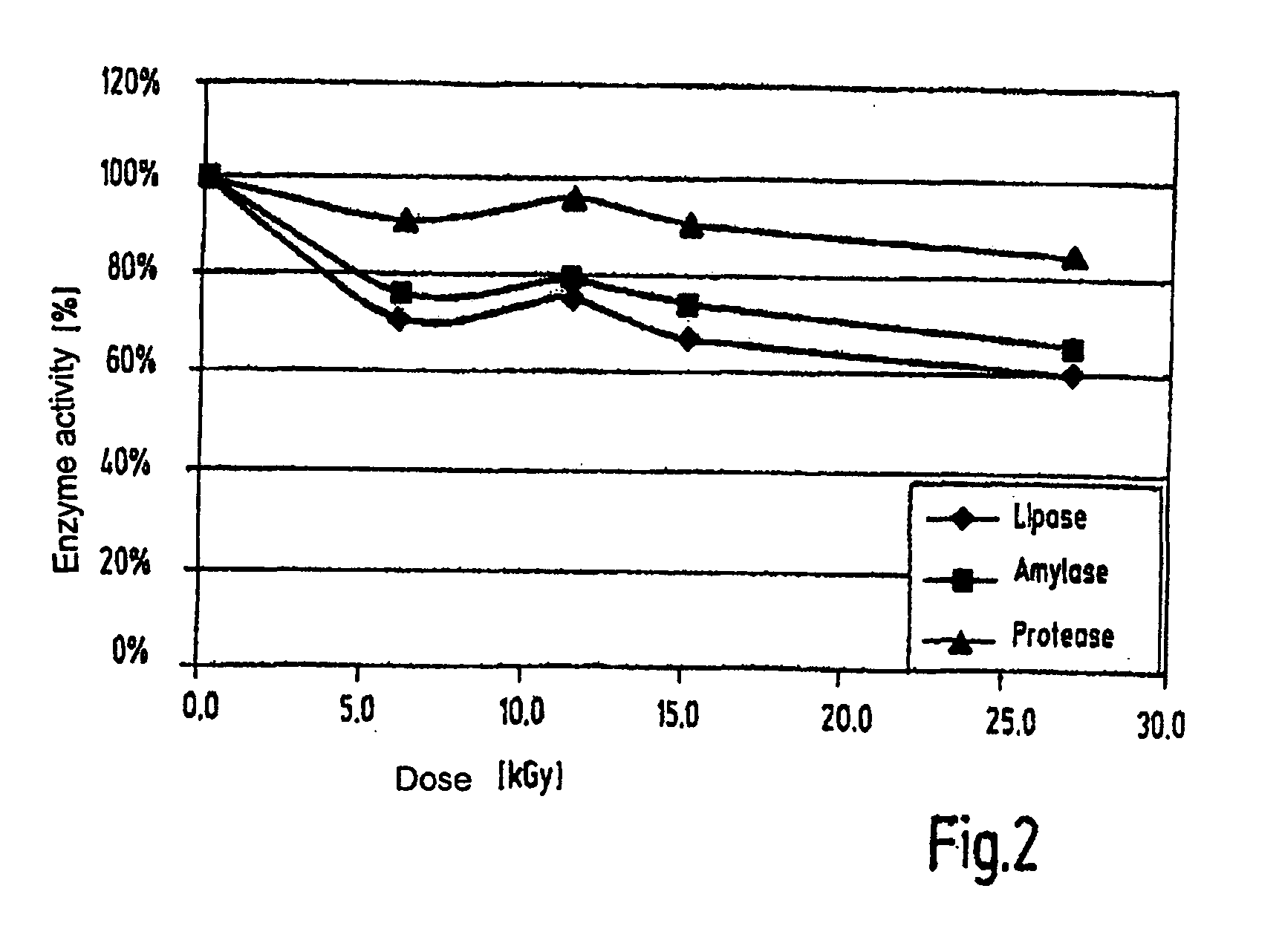Method for reducing the virus and micro-organism content of biological extracts which contain solids and extract produced according to the method
a biological extract and extract technology, applied in the field of biological extract virus and microorganism content reduction, can solve the problems that traditional virus-inactivating methods such as dry or moist heat or virus-depleting methods such as filtration or chromatography cannot be used in most cases with extracts from biological source materials, and the process is obviously not capable of removing, so as to reduce the activity of the enzymes contained, reduce the content of virus and microorganisms, and not impair the pharmacologically intended
- Summary
- Abstract
- Description
- Claims
- Application Information
AI Technical Summary
Benefits of technology
Problems solved by technology
Method used
Image
Examples
example 1
UV Irradiation of a Biological Extract which Contains Solids
[0047]The following example describes the treatment of pancreatin as a biological extract which contains solids and has been obtained from pig pancreas, with UV C radiation.
(1) Method
[0048]The experiments were carried out in a continuous throughput reactor. An intermediate stage, which was dissolved in 40% isopropanol, of the pancreatin production process was treated with UV C radiation (254 nm) at 2 J / cm2. This dose is normally sufficient for an effective inactivation of parvoviruses. An M2 phage was used as a model for PPV, which M2 phage is characterised like PPV by a very small genome. As the inactivation by UV irradiation is based on damage to the nucleic acids, a comparable genome size is particularly important for the transferability of the results. Alternatively, the same source material was exposed to UV C irradiation over a period of a plurality of hours in a batch stirring reactor and the kinetics of the phage in...
example 2
γ Irradiation of a Biological Extract which Contains Solids
[0051]The following example describes the treatment of pancreatin as a solid biological extract which has been obtained from pig pancreas, with γ radiation.
(1) Method
[0052]Pancreatin (active agent) was irradiated in doses of from 1 to 27 kGy and then checked for remaining enzymic activities. After a dose of 5 kGy, additional measurements of enzyme activity after 10 months (stability) and a determination of the CFU / g (germ content) were carried out.
(2) Results
[0053]The relative enzymic activities after treatment of pancreatin with different radiation doses in percent, based on the starting activity of the untreated sample are shown in FIG. 2. The stability of the pancreatic enzymes and the reduction of the germ content are shown in Table 1.
TABLE 1Stability of pancreatic enzymes and reduction ofgerm content after γ irradiation (5 kGy)LipaseAmylaseProteaseCFU / gactivity %activity %activity %%Before irradiation10010010047000After...
example 3
β Irradiation of a Biological Extract which Contains Solids
[0055]The following example describes the treatment of pancreatin as a biological extract which contains solids and has been obtained from pig pancreas, with β radiation.
(1) Method
[0056]Pancreatin (active agent) was irradiated in doses of from 4 to 20 kGy and then checked for remaining enzymic activities. The lipolytic activity was checked again after 3 and 6 months in storage.
(2) Results
[0057]The relative enzymic activity and germ count after treatment of pancreatin with different radiation doses is shown in FIG. 3. The enzyme activities in percent relate to the starting activities of the untreated sample. The lipase activity has been determined to check the stability after three and six months.
(3) Evaluation
[0058]When pancreatin was treated with β radiation, residual activities of >85% could be measured for all investigated enzymes even at a radiation dose of 20 kGy. At the same time the germ count was reduced by approx. 1...
PUM
| Property | Measurement | Unit |
|---|---|---|
| temperatures | aaaaa | aaaaa |
| temperature | aaaaa | aaaaa |
| temperatures | aaaaa | aaaaa |
Abstract
Description
Claims
Application Information
 Login to View More
Login to View More - R&D
- Intellectual Property
- Life Sciences
- Materials
- Tech Scout
- Unparalleled Data Quality
- Higher Quality Content
- 60% Fewer Hallucinations
Browse by: Latest US Patents, China's latest patents, Technical Efficacy Thesaurus, Application Domain, Technology Topic, Popular Technical Reports.
© 2025 PatSnap. All rights reserved.Legal|Privacy policy|Modern Slavery Act Transparency Statement|Sitemap|About US| Contact US: help@patsnap.com



